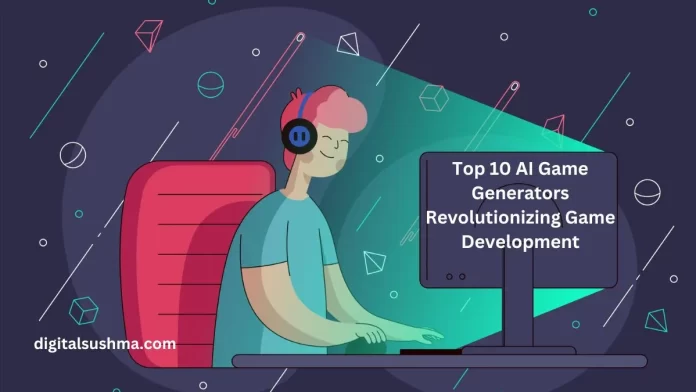The landscape of game development is rapidly evolving thanks to advancements in artificial intelligence (AI). AI-powered tools are streamlining and enhancing game creation in exciting new ways. From generating game art and assets to crafting immersive narratives, AI is bringing increased efficiency, creativity, and capability to game devs.
In this article, we will explore the top 10 AI game generators that are revolutionizing game development in 2023. For each tool, we will overview their key capabilities and benefits for game creation. We will also answer some frequently asked questions about how these AI generators work their magic. Read on to learn how you can harness the power of AI to enhance your next game project!
Top 10 AI Game Generators
1. Layer.ai – Automated 3D Layer Generation
Layer.ai simplifies 3D environment creation by using AI to automatically generate layers. This includes terrain, vegetation, buildings, rocks, and other elements that makeup game worlds.
With Layer.ai, you input parameters like environment size and Layer types you want to be generated. The AI will then output detailed 3D layers matching your specifications. You have control over layer features like vegetation density, terrain textures, building shapes, and more.
Layer.ai handles the grunt work of crafting individual 3D environment layers. This frees up devs to focus on higher-level design and art direction. The tool also optimizes layers so they render smoothly during gameplay.
2. Promethean AI – Automated 3D Environment Generation
Promethean AI accelerates game development by automatically generating 3D environments based on text descriptions. This groundbreaking tool lets you craft rich, detailed game worlds with ease.
Promethean AI supports an extensive range of environment types, including forests, beaches, cities, rooms, and more. You simply enter descriptive text about the scene you want generated, like “a dark, misty graveyard with crooked tombstones” or “a bright, clean robot factory in a futuristic city”. Promethean AI will then render a 3D environment matching your description.
With Promethean AI, you can devote more time to other aspects of game creation, versus manually building environments. It handles the heavy lifting so you can focus on gameplay mechanics, narratives, and overall experience.
3. Scenario – Customizable AI Art Generation
Scenario is an AI-powered tool specialized for creating unique, high-quality game art aligned with your specific art direction. Its standout feature is the ability to fine-tune AI models based on your custom art style.
You simply provide a Scenario with training data reflecting the visual style you want it to learn. This can include concept art, textures, color palettes, etc. Scenario’s AI will analyze your data and learn to generate new images matching your unique aesthetic.
With Scenario’s advanced image generation settings, you can produce up to 16 images per batch. You have precision control over image composition with 12 different modes. You can also iteratively modify images, extend content, and create new variations using different modes and features.
Overall, Scenario brings efficient, customized art creation to your workflow. Your game’s visuals can be remarkably consistent, saving you time while maintaining your artistic vision.
4. Ludo.ai – Adaptive Gameplay Experiences
Ludo.ai uses AI to analyze player behavior and dynamically adapt gameplay accordingly. This creates a tailored experience for each user based on their preferences, skill level, and play style.
The AI monitors metrics like where players are getting stuck, how they use certain mechanics, skill progression, and more. It then tweaks gameplay elements like challenge levels, tutorials, item drops, NPC interactions, and beyond to provide the right amount of difficulty, guidance, rewards, and fun for each player.
With Ludo.ai, you can provide personalized, rewarding gameplay that keeps users engaged. The AI handles the adaptation so you can focus on core game design.
5. Hotpot.ai – Multipurpose Creative AI Suite
Hotpot.ai offers a versatile suite of AI tools to assist with different creative tasks, from generating graphics and images to crafting marketing copy or social media posts. While not a specialized game dev tool, many of Hotpot’s features can provide value for game creation.
Key capabilities include:
– AI Art Generator – Creates unique images from text prompts
– AI Image Enhancer – Increases image resolution and quality
– AI Copywriting – Generates marketing/promotional text
– AI Logo Creator – Designs custom logos
– Social Media Tools – Creates posts, ads, and assets
– Device Mockups – Render device screenshots
– Icon Creator – Produces icons for mobile apps
Hotpot.ai makes it fast and simple to produce various graphics, images, and text needed for game marketing and promotion. The AI does the heavy lifting, allowing you to focus on your game.
6. Rosebud.ai – Photorealistic Character Creation
Rosebud.ai leverages AI to generate photorealistic 2D character art. This tool makes creating unique, quality characters faster and simpler compared to manual techniques.
With Rosebud.ai, you can input textual descriptions of a character’s physical attributes and outfits. Rosebud will generate multiple character images matching your specifications. You can guide the AI by providing example images reflecting the visual style you desire.
Rosebud.ai gives you granular control over attributes like hair style/color/length, skin tone, facial features, body type, clothing, accessories, and more. You can iterate rapidly to fine-tune characters until they perfectly fit your vision.
Overall, Rosebud.ai brings efficiency and consistency to 2D character art creation. You can populate your games with diverse, quality characters true to your creative direction.
7. Meshy – 3D Mesh Management and Optimization
Meshy provides a suite of AI-powered tools for optimizing 3D meshes for better game performance. Key features include:
– Mesh Analysis & Insights – Identifies mesh issues for correction
– Automatic Retopology – Improves topology without losing detail
– Automatic UV Unwrapping – Efficiently maps textures to meshes
– Mesh Simplification – Reduces poly count while maintaining visuals
– LOD Generation – Creates optimized levels of detail
– Compression – Decreases file sizes for reduced loading times
With Meshy’s AI mesh management, you can ensure optimal meshes that render quickly and smoothly. The AI handles tedious optimization tasks so you can just focus on 3D modeling and texturing.
8. Leonardo AI – Game Asset Generation and Optimization
Leonardo AI uses AI to automate the creation of high-quality game assets like 3D models, textures, materials, animations, and more. This enables game devs to populate their worlds with unique assets faster than manual methods.
Leonardo AI’s generative capabilities paired with its optimization features are a winning combo. The AI analyzes your meshes and textures to provide optimization suggestions for maximizing in-game performance across devices. This ensures assets not only look great, but also render smoothly during gameplay.
Leonardo AI can handle rigging, animations, lighting, and other tasks to make assets game-ready. With Leonardo AI, you spend less time on asset generation and performance optimization.
9. Charisma – Dynamic Narrative Generation
Charisma leverages AI to generate interactive storylines, characters, and dialog that adapt based on user actions. This brings new depth and replayability to game narratives.
Charisma analyzes player behavior to construct narratives that align with their play style. Story outcomes, events, character roles, and dialog trees evolve based on user choices. Charisma handles creating dynamic narratives so devs can focus on core mechanics and gameplay.
Charisma also generates quality character dialog. Its natural language capabilities create conversations and scripts that sound authentic and believable for more immersive stories.
10. InWorld – Photorealistic Character Generation
InWorld utilizes AI to create photorealistic 2D and 3D renditions of characters based on your descriptive inputs. Like Rosebud.ai, this tool makes populating your games with quality characters more automated.
InWorld provides granular controls over traits like physique, facial features, skin, hair, makeup, clothing, and accessories. The AI generates images and 3D models matching your specifications. You can refine generations by providing example images to influence the style.
InWorld also enables mixing and matching character elements. You can easily swap hairstyles, outfits, and other traits to create new variations without starting over. This iterative approach helps you design distinct characters faster.
Bonus: GANimator – Fluid Character Animation
While not one of the top 10 tools, GANimator deserves an honorable mention for its AI-powered animation capabilities. This tool utilizes generative adversarial networks (GANs) to create realistic, fluid character animations for games and film.
GANimator analyzes motion references to learn realistic physics. The AI then generates new seamless animations matching your direction. This includes walking, jumping, gesturing, and more. Developers can guide the AI by providing examples of motions they want to be replicated or avoided.
Overall, GANimator makes bringing game characters and creatures to life intuitive and efficient. Its neural motion sequencing handles the complexities so devs can focus on animation art direction.
The Future of AI in Game Development
As highlighted in this article, AI is already revolutionizing major aspects of game creation. And capabilities will only expand as the technology continues advancing rapidly. We can expect AI to take on more responsibilities across game design, asset production, QA testing, monetization, and beyond.
While AI will allow devs to work smarter and foster more creativity, the human touch remains essential. Devs still need to provide vision, imagination, and oversight to guide AI tools towards constructive outcomes. Finding the right balance of AI automation and human direction will drive the future of game development.
Conclusion
AI game generators like the 10 covered here are transforming workflows for pro and indie devs alike. These tools automate tedious, repetitive tasks so developers can dedicate more energy toward vision and gameplay.
From streamlining environment and character art to optimizing technical aspects like narratives, assets, and animations, AI is leveling up game creation. While still early days, the capabilities of these game dev AI tools will only grow. Forward-looking studios should keep exploring how AI can enhance their game projects today and in the future.






